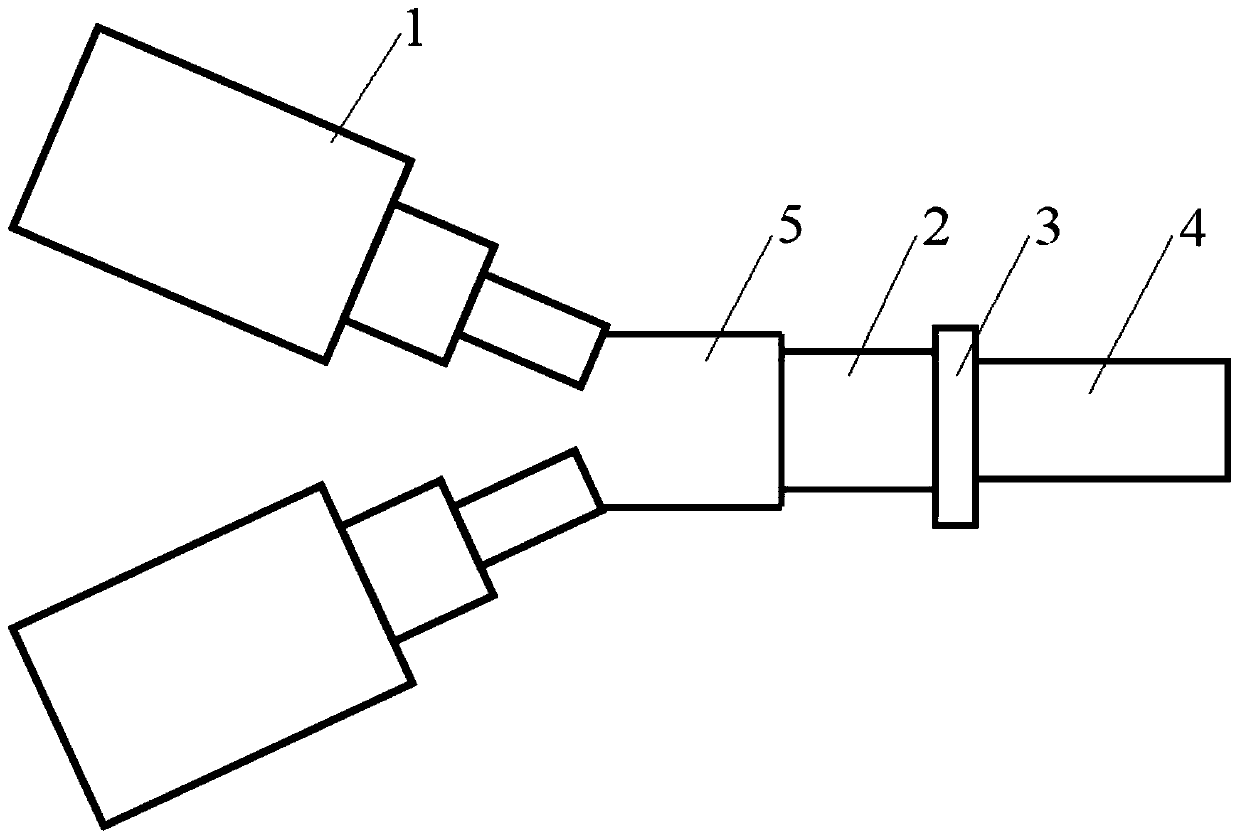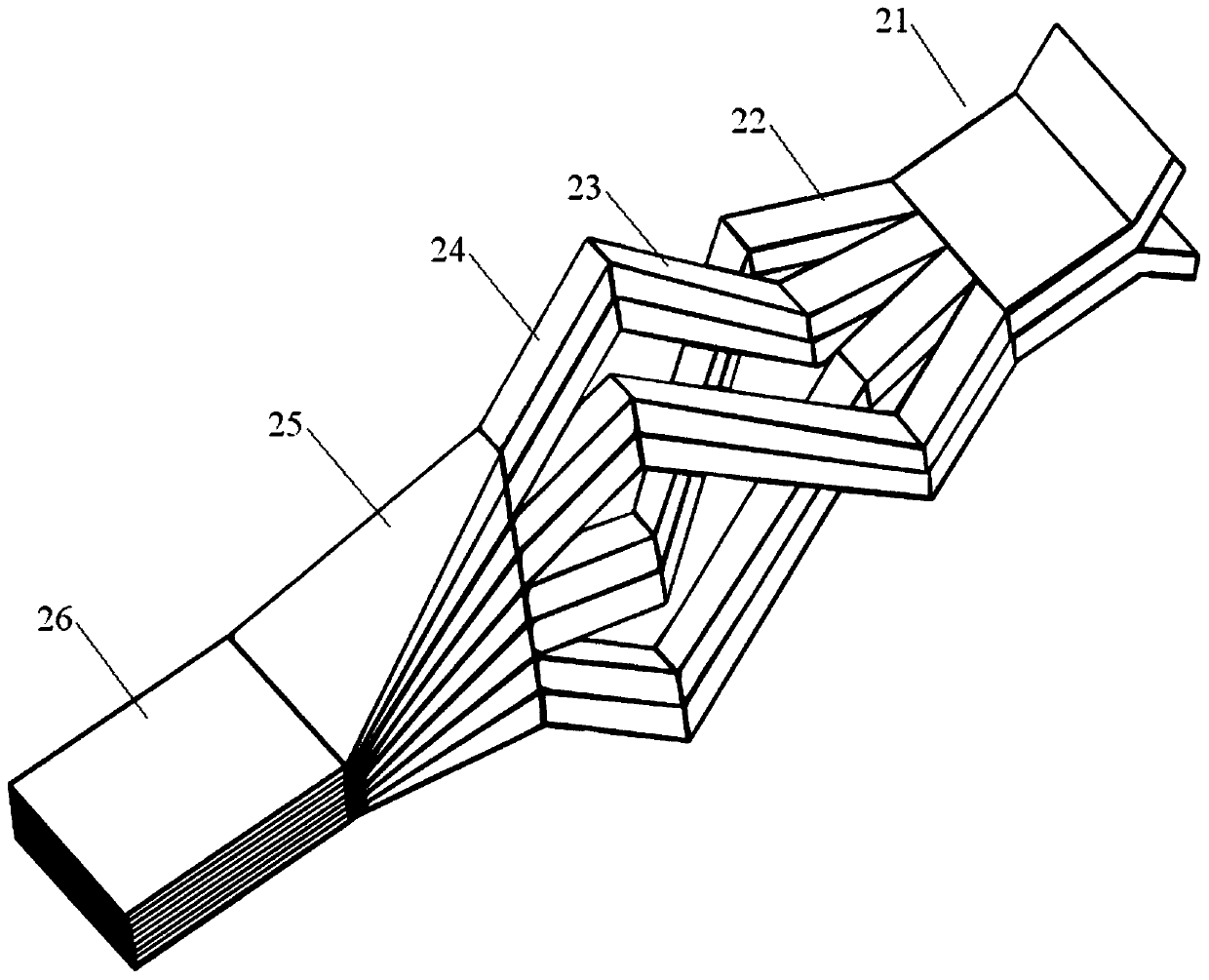Multilayer composite polypropylene microporous membrane, preparation method thereof and application
A polypropylene microporous film and multi-layer composite technology, which is applied in the direction of electrical components, circuits, battery components, etc., can solve the problems of uneven hole formation and uncontrollable size of microporous films, and achieve good safety and avoid Potential safety hazards, effects of improving tensile strength and puncture strength
- Summary
- Abstract
- Description
- Claims
- Application Information
AI Technical Summary
Problems solved by technology
Method used
Image
Examples
Embodiment 1
[0037] The polyolefin microporous membrane preparation device of this example, wherein, the part that is used to prepare the middle layer of the multi-layer structure of micro-nano lamination, such as figure 1 As shown, it includes two extruders 1, co-extrusion module 5, micro-nano layer multiplier 2, extrusion die 3 and cooling traction module 4; wherein, two extruders 1 are used to extrude and prepare the middle layer respectively Two different specifications of polypropylene raw materials; the co-extrusion module 5 is set at the output port of the two extruders, and is used to merge and extrude the polyolefin materials extruded by the two extruders, and then transport them to the micro-nano layer The multiplier 2; the micro-nano layer multiplier 2 is a split-layer container as a whole, which is used to divide the molten polyolefin material extruded by the co-extrusion module 5 into several strands, and then each strand forms a layer, and finally forms several layers Laminat...
Embodiment 2
[0048] This example adopts the same device and method as in Example 1 to prepare a multilayer composite polypropylene microporous membrane. The difference is that the multilayer composite polypropylene microporous membrane of this example has an isotacticity of 98% and a melt index of Made of 1.3g / 10min polypropylene, the lower surface layer is made of polypropylene and the upper surface layer is the same, the isotacticity of the first polypropylene in the middle layer is 97%, the melt index is 0.8g / 10min, and the isotacticity of the second polypropylene is 98%, and the melt index is 1.3g / 10min. The middle layer is a cross-stacked 16-layer composite structure formed by 8-layer first polypropylene layer and 8-layer second polypropylene layer through micro-nano lamination technology. The preparation of the 16-layer stacked middle layer specifically uses three series-connected micro Nanolayer multiplier. The total thickness of the polyolefin microporous membrane of this example ...
Embodiment 3
[0051] This example adopts the same device and method as in Example 1 to prepare a multilayer composite polypropylene microporous membrane. It is made of 1.5g / 10min polypropylene, the lower surface layer is made of polypropylene and the upper surface layer is the same, the isotacticity of the first polypropylene in the middle layer is 98.5%, the melt index is 0.6g / 10min, and the isotacticity of the second polypropylene is 97%, the melt index is 1.5g / 10min. The middle layer is a cross-stacked 32-layer composite structure formed by micro-nano lamination technology with 16 layers of the first polypropylene layer and 16 layers of the second polypropylene layer. Four series-connected micro Nanolayer multiplier. The total thickness of the polyolefin microporous membrane of this example is 16 microns, the thickness of the upper surface layer is 2 microns, the thickness of the lower surface layer is 2 microns, the thickness of the middle layer is 12 microns, and the thickness of the ...
PUM
| Property | Measurement | Unit |
|---|---|---|
| melt flow index | aaaaa | aaaaa |
| thickness | aaaaa | aaaaa |
| thickness | aaaaa | aaaaa |
Abstract
Description
Claims
Application Information
 Login to View More
Login to View More - R&D
- Intellectual Property
- Life Sciences
- Materials
- Tech Scout
- Unparalleled Data Quality
- Higher Quality Content
- 60% Fewer Hallucinations
Browse by: Latest US Patents, China's latest patents, Technical Efficacy Thesaurus, Application Domain, Technology Topic, Popular Technical Reports.
© 2025 PatSnap. All rights reserved.Legal|Privacy policy|Modern Slavery Act Transparency Statement|Sitemap|About US| Contact US: help@patsnap.com



